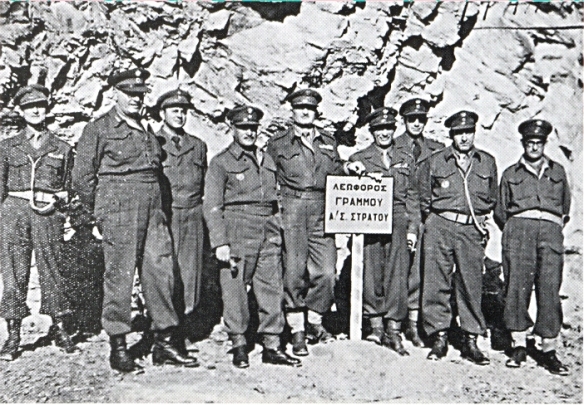The leadership of the National Army after the successful operations in Grammos sector (Operation Pyrsos/Torch).
Organisation and military bases of the “Democratic Army”, as well as entry routes to Greece (legend in Greek).
Conflict fought between the Greek Communist Party (KKE) and anticom- munist Greek nationalists. Greece’s civil war was rooted in age-old divisions within Greek society and was complicated by the rivalry between the Soviet Union and the United States. The nationalists were strongly supported by Britain and the United States. The war was one of the earliest Cold War tests of will between East and West and claimed the lives of an estimated 80,000 Greeks, a fatality rate that surpassed the suffering of that nation in World War II. Both sides committed atrocities and tried to settle old scores under the guise of conflicting ideologies. The conflict’s greatest legacy was the Tru- man Doctrine, which committed the United States and its allies to come to the aid of any nation threatened by communist takeover. This set the stage for President Harry S. Truman’s containment policy.
In the early years of the twentieth century, conservative and liberal parties in Greece struggled for power, engaging in a series of bloodless purges that heightened political instability and created great anger and bitterness. This atmosphere provided fertile ground for authoritarianism, and in 1936 General Ioannis Metaxas established a fascist-style dictatorship, further polarizing the country.
Metaxas’s death in 1941 and the flight of the Greek government to Egypt after the German invasion left Greece in virtual chaos. The KKE, persecuted under Metaxas, stepped into the power vacuum by creating the National Liberation Front (EAM), dedicated to the liberation of Greece. By 1944 the EAM boasted nearly 2 million members, and its military arm, the National Liberation Army (ELAS), had enlisted 50,000 fighters.
In October 1944, British Prime Minister Winston Churchill, fearful of a communist takeover in Greece and the loss of control over the eastern Mediterranean, met with Soviet Premier Josef Stalin in Moscow and struck a deal over control of the Balkans. In return for Soviet dominance in Bulgaria, Romania, and Poland, Stalin ceded Greece to Great Britain and vowed not to directly support the KKE after the war.
Relations between the British-backed Greek monarchy and the EAM quickly soured as the communists suppressed dissent and tried to assert control over the country. In retaliation, the British rehabilitated the collaborationist police, returned monarchist military units to the nation, and demanded that the ELAS disarm. On 2 December 1944 collaborationist police fired on antigovernment demonstrators, triggering the Battle for Athens. It resulted in a victory for the nationalists and the disarming of the ELAS. The EAM splintered as moderates and socialists abandoned it, while KKE membership plummeted from its peak of more than 400,000 to only 50,000. KKE leader Nikos Zachariades attempted to impose tighter party discipline but was stymied by the strength of the nationalist forces.
In an attempt to maintain order, the British strengthened the Greek National Guard and turned a blind eye as security forces conducted a campaign of repression against the communists. In the Greek parliamentary elections of March 1946, the rightist candidates won a landslide victory. The allegedly rigged elections prompted the KKE to declare a state of civil war and reorganize ELAS units as the Democratic Army of Greece (DSE). The DSE won notable gains in the first year of fighting due in part to support from the communist governments of Yugoslavia and Albania.
Fearing that the nationalists might indeed lose the war against the DSE, the British appealed for help from the United States. Previous British requests for American assistance in Greece had been rebuffed, but by 1947 American attitudes had begun to change. President Truman’s growing antipathy toward the Soviets and their tightening of control in Eastern Europe hardened his stance. On 12 March 1947, he addressed a joint session of Congress, enunciating the Truman Doctrine and requesting a $300 million aid package to support the Greek nationalists and anticommunists in nearby Turkey.
The KKE did not take the Truman Doctrine seriously, believing that the nationalists would capitulate even with U. S. support. By 1948, however, it was becoming clear that the DSE was in dire straits as the American-backed nationalist army grew exponentially. In January 1949, KKE leaders foolishly declared that the goal of the civil war was no longer the restoration of parliamentary democracy, as they had previously stated, but rather the establishment of a proletarian dictatorship. The DSE then shifted from a mobile war of attrition to a campaign to defend territory, a tactical miscalculation that played into the hands of the revitalized nationalist army.
In the spring of 1949, the nationalist army cleared the communist rebels out of southern Greece and launched a two-pronged offensive designed to drive them completely out of the country. As the fighting reached its climax, Yugoslavia closed its border and ended arms shipments that had kept the DSE insurgency viable. After sustaining more than 2,000 casualties in the summer of 1949, DSE fighters withdrew into Albania during the night of 29 August 1949, effectively ending the civil war. Although sporadic DSE raids continued into 1950, the victory of the nationalist forces was by then complete.
References: Clogg, Richard. A Concise History of Greece. 2nd ed. Cambridge: Cambridge University Press, 2002. Close, David H. The Greek Civil War, 1943–1950: Studies of Polarization. London: Routledge, 1993. ———. The Origins of the Greek Civil War. New York: Longman, 1995. Gerolymatos, Andre. Red Acropolis, Black Terror: The Greek Civil War and the Origins of Soviet-American Rivalry. New York: Basic Books, 2004. Iatrides, John O. Greece in the 1940s: A Nation in Crisis. Hanover, NH: University Press of New England, 1981.
